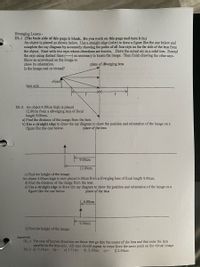Question
thumb_up100%
DL-1 please

Transcribed Image Text:Diverging Lenses -
DL-1 (The back side of this page is blank. Do you work on this page and turn it in.)
An object is placed as shown below. Use a straight edge (ruler) to draw a figure like the one below and
complete the ray diagram by accurately showing the paths of all four rays on the far side of the lens from
the object. Start with two rays whose directions are known. Draw the actual ray as a solid line. Extend
the rays using dashed lines (----) as necessary to locate the image. Then finish drawing the other rays.
Show an arrowhead on the image to
show its orientation.
Is the image real or virtual?
plane of diverging lens
object
lens axis
f
f
DL-2 An object 4.00cm high is placed
12.00cm from a diverging lens of focal
length 9.00cm.
a) Find the distance of the image from the lens.
b) Use a straight edge to draw the ray diagram to show the position and orientation of the image on a
figure like the one below.
plane of the lens
9.00cm
12.00cm
c) Find the height of the image.
An object 4.00cm high is now placed 6.00cm from a diverging lens of focal length 9.00cm.
d) Find the distance of the image from the lens.
e) Use a straight edge to draw the ray diagram to show the position and orientation of the image on a
figure like the one below.
plane of the lens
6.00cm
9.00cm
f) Find the height of the image.
Answers
DL-1 The rays of known direction are those that go thru the center of the lcns and that enter the lens
parallel to the lens axis. All rays should appear to come from the same point on the virtual image.
DL-2 a) -5.14cm b)-- c) 1.71cm
d) -3.60cm e)--- ) 2.40cm
Expert Solution
This question has been solved!
Explore an expertly crafted, step-by-step solution for a thorough understanding of key concepts.
This is a popular solution
Trending nowThis is a popular solution!
Step by stepSolved in 2 steps with 2 images

Knowledge Booster
Similar questions
- Major: Electrical Engineering Course: EE350 ( System Dynamics and Control )arrow_forwardA mass spectrometer is being used to separate common oxygen-16 from the much rarer oxygen-18, taken from a sample of old glacial ice. The ratio of the masses of these two ions is 16 to 18, and the mass of oxygen-16 is 2.66×10^−26 kg. They are both singly charged, and they both travel at 4.84×10^6 m/swhen they enter the mass spectrometer with a 1.11T magnetic field that is perpendicular to the particle velocity. What is the separation between their paths, in meters, when they hit a target after traversing a semicircle?arrow_forward95. Select 1 answer.arrow_forward
- Use the equation E=Fq E= Gravitational constant q= mass of the protonarrow_forwardThe velocity selector in the problem prior to this one is used in a mass spectrometer. Protons(with zero neutrons) are the most common hydrogen nuclei. Some hydrogen isotopes, however, haveeither one or two neutrons in addition to the proton. If a beam of hydrogen nuclei is shot into amagnetic field of strength 2.0T and the nuclei do a u-turn after which they strike a detector, how farapart will the three isotopes be on the detector surface? Assume both protons and neutrons have amass of 1.67 × 10−27kg and e = 1.60 × 10−19C.arrow_forwardA square loop has a charge density λ = |x| at y = ±a and [x]arrow_forward
- Please circle answerarrow_forward2. Consider the mass spectrometer shown schematically in the figure below. The electric field between the plates of the velocity selector is 4.81 x 105 V/m, and the magnetic fields in both the velocity selector and the deflection chamber have magnitudes of .313 T. (a) Calculate the radius r of the path for a singly charged positive ion with mass m = 5.14 x 10-26 kg. (b) If the length of the velocity selector was 3.00 m long then how much total time will the particle spend in the spectrometer? Bo.in P Photographic plate Bin Velocity selector xX-- ----arrow_forward22) An x-ray tube used for cancer therapy operates at 4.0 MV, with a beam current of 25 mA striking a metal target. Nearly all the power in the beam is transferred to a stream of water flowing through holes drilled in the target. What rate of flow, in kilograms per second, is needed if the rise in temperature (ΔT) of the water is not to exceed 50 C ?arrow_forward
arrow_back_ios
arrow_forward_ios